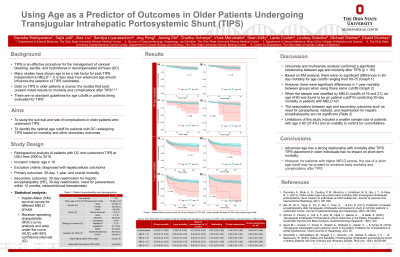Monday Poster Session
Category: Liver
P2350 - Using Age as a Predictor of Outcomes After Transjugular Intrahepatic Portosystemic Shunt
Monday, October 23, 2023
10:30 AM - 4:15 PM PT
Location: Exhibit Hall

Has Audio

Gavisha Waidyaratne, MD
The Ohio State University Wexner Medical Center
Columbus, OH
Presenting Author(s)
Gavisha Waidyaratne, MD1, Sajid Jalil, MD2, Alex Liu, MD3, Sandya Liyanarachchi, MS, MAS4, Jing Peng, PhD1, Jianing Ma, MS1, Chathur Acharya, MBBS5, Vivek Mendiratta, MD1, Sean G. Kelly, MD1, Lanla F. Conteh, MD, MBA, MPH1, Lindsay A. Sobotka, DO2, Michael Wellner, MD1, Khalid Mumtaz, MBBS1
1The Ohio State University Wexner Medical Center, Columbus, OH; 2The Ohio State Wexner Medical Center, Columbus, OH; 3Mayo Clinic, Rochester, MN; 4The Ohio State University, Columbus, OH; 5Ohio State University, Columbus, OH
Introduction: TIPS is an effective procedure for the management of complications of decompensated cirrhosis. Multiple independent studies suggest that older age is an important predictor of survival and post-TIPS hepatic encephalopathy. Despite this, data studying an optimal age cutoff for TIPS is lacking. We aim to assess the impact of different age cutoffs on post-TIPS mortality and other clinically significant outcomes.
Methods: This retrospective study included adults with cirrhosis who underwent TIPS at The Ohio State University between 2000 and 2018. Various cutoffs of age were used including ≥ 60, ≥65 and ≥70 years. Primary outcomes studied were 30-day, 1-year, and overall mortality. Secondary outcomes were readmission for hepatic encephalopathy (HE) within 30 days, overall readmission within 30 days, need for paracentesis within 12 months, and rebleed.
Results: During the study period, 227 patients underwent TIPS. The mean age of participants was 55.59 (±10.7). Of the cohort, 37.3% were age ≥ 60, 19.8% were age ≥ 65, and 7.2% were age ≥ 70. Comparisons of survival between patients age < 60 and age ≥ 60 yielded a hazard ratio (HR) of 0.74 (p = .47) and 1.66 (p = .04) for 30-day and 1-year mortality respectively. Comparisons of survival between patients age < 65 and age ≥ 65 yielded a HR of .96 (p = .93) and 2.28 (p = .002) for 30-day and 1-year mortality respectively. Comparisons of survival between patients age < 70 and age ≥ 70 yielded a HR of 2.55 (p = .085) and 2.86 (p = .004) for 30-day and 1-year mortality respectively. There was no significant difference in rates of 30-day readmission, readmission within 30 days for HE, need for paracentesis within 12 months, or rebleed between groups based on age cutoffs of 60, 65, or 70 (Table 1).
Discussion: Our data suggests that increasing age above the tested age cutoffs is not associated with short term mortality. In addition, older age is not associated with worse secondary outcomes after TIPS. However, the association between older age and poor 1-year mortality is notable. Our findings are useful in pursuing TIPS in older patients with good short-term outcomes.
Disclosures:
Gavisha Waidyaratne, MD1, Sajid Jalil, MD2, Alex Liu, MD3, Sandya Liyanarachchi, MS, MAS4, Jing Peng, PhD1, Jianing Ma, MS1, Chathur Acharya, MBBS5, Vivek Mendiratta, MD1, Sean G. Kelly, MD1, Lanla F. Conteh, MD, MBA, MPH1, Lindsay A. Sobotka, DO2, Michael Wellner, MD1, Khalid Mumtaz, MBBS1. P2350 - Using Age as a Predictor of Outcomes After Transjugular Intrahepatic Portosystemic Shunt, ACG 2023 Annual Scientific Meeting Abstracts. Vancouver, BC, Canada: American College of Gastroenterology.
1The Ohio State University Wexner Medical Center, Columbus, OH; 2The Ohio State Wexner Medical Center, Columbus, OH; 3Mayo Clinic, Rochester, MN; 4The Ohio State University, Columbus, OH; 5Ohio State University, Columbus, OH
Introduction: TIPS is an effective procedure for the management of complications of decompensated cirrhosis. Multiple independent studies suggest that older age is an important predictor of survival and post-TIPS hepatic encephalopathy. Despite this, data studying an optimal age cutoff for TIPS is lacking. We aim to assess the impact of different age cutoffs on post-TIPS mortality and other clinically significant outcomes.
Methods: This retrospective study included adults with cirrhosis who underwent TIPS at The Ohio State University between 2000 and 2018. Various cutoffs of age were used including ≥ 60, ≥65 and ≥70 years. Primary outcomes studied were 30-day, 1-year, and overall mortality. Secondary outcomes were readmission for hepatic encephalopathy (HE) within 30 days, overall readmission within 30 days, need for paracentesis within 12 months, and rebleed.
Results: During the study period, 227 patients underwent TIPS. The mean age of participants was 55.59 (±10.7). Of the cohort, 37.3% were age ≥ 60, 19.8% were age ≥ 65, and 7.2% were age ≥ 70. Comparisons of survival between patients age < 60 and age ≥ 60 yielded a hazard ratio (HR) of 0.74 (p = .47) and 1.66 (p = .04) for 30-day and 1-year mortality respectively. Comparisons of survival between patients age < 65 and age ≥ 65 yielded a HR of .96 (p = .93) and 2.28 (p = .002) for 30-day and 1-year mortality respectively. Comparisons of survival between patients age < 70 and age ≥ 70 yielded a HR of 2.55 (p = .085) and 2.86 (p = .004) for 30-day and 1-year mortality respectively. There was no significant difference in rates of 30-day readmission, readmission within 30 days for HE, need for paracentesis within 12 months, or rebleed between groups based on age cutoffs of 60, 65, or 70 (Table 1).
Discussion: Our data suggests that increasing age above the tested age cutoffs is not associated with short term mortality. In addition, older age is not associated with worse secondary outcomes after TIPS. However, the association between older age and poor 1-year mortality is notable. Our findings are useful in pursuing TIPS in older patients with good short-term outcomes.
Disclosures:
Gavisha Waidyaratne indicated no relevant financial relationships.
Sajid Jalil indicated no relevant financial relationships.
Alex Liu indicated no relevant financial relationships.
Sandya Liyanarachchi indicated no relevant financial relationships.
Jing Peng indicated no relevant financial relationships.
Jianing Ma indicated no relevant financial relationships.
Chathur Acharya indicated no relevant financial relationships.
Vivek Mendiratta indicated no relevant financial relationships.
Sean Kelly indicated no relevant financial relationships.
Lanla Conteh indicated no relevant financial relationships.
Lindsay Sobotka indicated no relevant financial relationships.
Michael Wellner indicated no relevant financial relationships.
Khalid Mumtaz indicated no relevant financial relationships.
Gavisha Waidyaratne, MD1, Sajid Jalil, MD2, Alex Liu, MD3, Sandya Liyanarachchi, MS, MAS4, Jing Peng, PhD1, Jianing Ma, MS1, Chathur Acharya, MBBS5, Vivek Mendiratta, MD1, Sean G. Kelly, MD1, Lanla F. Conteh, MD, MBA, MPH1, Lindsay A. Sobotka, DO2, Michael Wellner, MD1, Khalid Mumtaz, MBBS1. P2350 - Using Age as a Predictor of Outcomes After Transjugular Intrahepatic Portosystemic Shunt, ACG 2023 Annual Scientific Meeting Abstracts. Vancouver, BC, Canada: American College of Gastroenterology.
